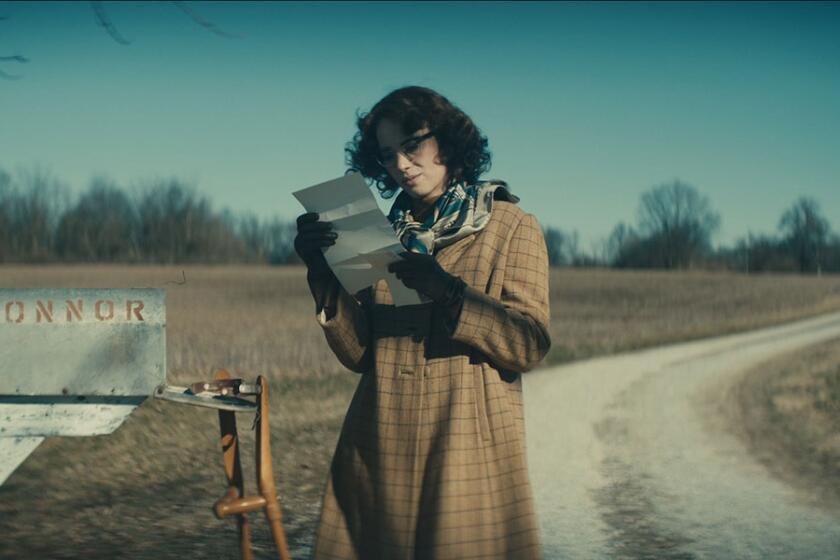Rescued before they were gone forever
Imagine if the only way you could see Old Master paintings was through reproductions. The legendary art collector Albert C. Barnes called those “a hearsay version of a honeymoon narrated by an octogenarian.” Or if the only way to experience the beauties of nature was through picture postcards.
That’s what the world of film would be like without the wonders of preservation.
Anyone who has suffered through a badly scratched film at a dismal multiplex knows how appallingly the quality of a print can deteriorate even in a current release. Imagine the degeneration that happens to a film that is 50, 60, even 80 years old. Without the kind of preservation and restoration undertaken by archives around the world, the great classics of cinema, not to mention the odd curiosities that viewers treasure, would not be available to be seen the way their creators intended, if at all.
The UCLA Film and Television Archive, which hosts its own marvelous festival of preservation every other year, has chosen in this off year to do a tribute to work done by close to a dozen like-minded institutions around the world, including Italy’s Cineteca di Bologna, the Cinematheque Francaise, the National Film Archive of India and the George Eastman House in Rochester, N.Y.
As with its own festival, the range of films in this International Preservation series, showing Friday through Aug. 26, is staggering.
This will be a chance to see drop-dead rarities such as the melodious early Indian sound film “Sant Tukaram” as well as acknowledged masterpieces such as Fritz Lang’s crackling “Spies” and Jean Renoir’s legendary “Nana” -- which the director called “my first film worth talking about” -- with his wife, Catherine Hessling, in the title role.
Some of the films that needed restoration are unexpectedly modern, including 1964’s “Zorba the Greek” and Lionel Rogosin’s landmark “Come Back, Africa” from 1960. The strangest of these could well be 1953’s “Anatahan,” the rarely seen last work by the legendary director Josef von Sternberg. Based on the true story of Japanese soldiers who didn’t surrender until years after World War II’s end, this unusual film, eccentric, poetic and unnervingly personal, has been argued about by critics since the day it was released.
Another sound film not to be missed is William Wyler’s 1931 pre-Code gem, “A House Divided.” It stars Walter Huston as fisherman Seth Law, an overpoweringly masculine presence who creates a crisis for his sensitive son when he sends for a comely mail-order bride from a small town in Montana. Oedipal tensions bristle, storms at sea create waves that “The Perfect Storm” might envy, and all in a brisk 68 minutes.
Many of the restorations in the International Preservation series turn out to be silents. To a degree that is surprising, silent films are continually being rediscovered, invariably in poor condition and often in out-of-the-way corners of the world.
At the most basic level, silent films (here accompanied by pianist Michael Mortilla) were painfully mistreated in their day. As silent film historian Kevin Brownlow, who knows the most about that world, has said, these films have endured “a record of destruction worthy of Attila the Hun: They have burned them, dumped them in the sea, hacked the reels with axes, or let them rot in vaults.” As a result, estimates on how many silent films survive range from 20% to a third of those made.
Those that do survive are often to be found in private collections or state-run archives in places that were terminal points of studio distribution systems so lackadaisical they didn’t take the trouble to send the prints back. And because film cans are often mislabeled -- sometimes intentionally -- funding is needed to project unknown or mislabeled films to determine what they are. So it can take decades before archives have the wherewithal to thoroughly examine their holdings and know exactly what it is they have.
Also part of the mix are the vagaries of those private collectors. When Sight & Sound magazine wrote about the recently rediscovered and Netherlands’ Filmmuseum-restored “Beyond the Rocks,” which debuted this year at Cannes, it gave this description of the breed:
“Film collectors are a notoriously secretive bunch, squirreling away their treasures with the same selfish mania that prompts Bond villains to pilfer celebrated works of art. The elusive Joop van Liemp could act as poster boy for the species, amassing approximately 2,000 unlabeled cans of film which he stored in a deliberately higgledy-piggledy manner, dividing up reels from the same title and creating a cataloger’s nightmare for the archivists at the Netherlands museum when his collection came into their hands.”
These kinds of shenanigans are nothing new. One of the great Japanese silents, Teinosuke Kinugasa’s 1926 “A Page of Madness,” was found in a rice barrel in the garden of the director’s country home. “The Last of the Duanes,” a celebrated Tom Mix western, was discovered under layers of bird excrement on the floor of a chicken farm building in a remote Czech village.
Significant films have been found in places as varied as an abandoned swimming pool in the Yukon and the basement of a Danish tavern where Peter the Great once spent the night.
One of the most charming films in the UCLA series, John Ford’s “Bucking Broadway,” had a similar story: It sat in a French film archive for 30 years until someone realized what was in those cans simply labeled “Far West Drama.” Dating from 1917, this story of Cheyenne Harry and a city slicker in pursuit of the same girl is one of the earliest of Ford’s films that survives.
It stars frequent Ford collaborator Harry Carey and, even this early in their relationship, Carey’s gifts as an actor and the bond he forged with his director are plainly visible.
Also benefiting from rediscovery are a pair of Swedish silents that constitute the most unexpected bill of the series. Mauritz Stiller’s 1915 “The Avenger,” thought lost until a print turned up in a Berlin archive in 2001, has anti-Semitism as a theme. Even more provocative is 1910’s “The Abyss,” the film whose remarkably erotic “gaucho dance” made Asta Nielsen the cinema’s first international star.
Seeing these films underlines once again the truth of Brownlow’s famous dictum about early films: “It’s hard to understand the last reel if you haven’t seen the first.”
*
Kenneth Turan is a Times film critic. Contact him at calendar.letters@latimes.com.
*
International Preservation series
Where: UCLA Film and Television Archive, James Bridges Theater, Melnitz Hall. (310) 206-FILM or www.cinema.ucla.edu.
When: Films at 7:30 p.m. unless otherwise noted.
Schedule
Friday: “Nana”
Saturday: “Be My Wife,” “Bucking Broadway,” “The Devil’s Circus”
Next Sunday: “Come Back, Africa,” 7 p.m.; “The Blues Under the Skin”
Aug. 3: “People on Sunday,” “Underground”
Aug. 5: “Zorba the Greek”
Aug. 10: “Sant Tukaram”
Aug. 14: “The Love Eterne,” 7 p.m.
Aug. 18: “The Abyss,” “The Avenger,” “Kiss of Death”
Aug. 19: “Spies”
Aug. 20: “A House Divided,” “The Unholy Three”
Aug. 21: “Yukoku,” 7 p.m.; “The Inner Scar”
Aug. 24: “The Queen of Spades”
Aug. 26: “Anatahan”
More to Read
Only good movies
Get the Indie Focus newsletter, Mark Olsen's weekly guide to the world of cinema.
You may occasionally receive promotional content from the Los Angeles Times.







